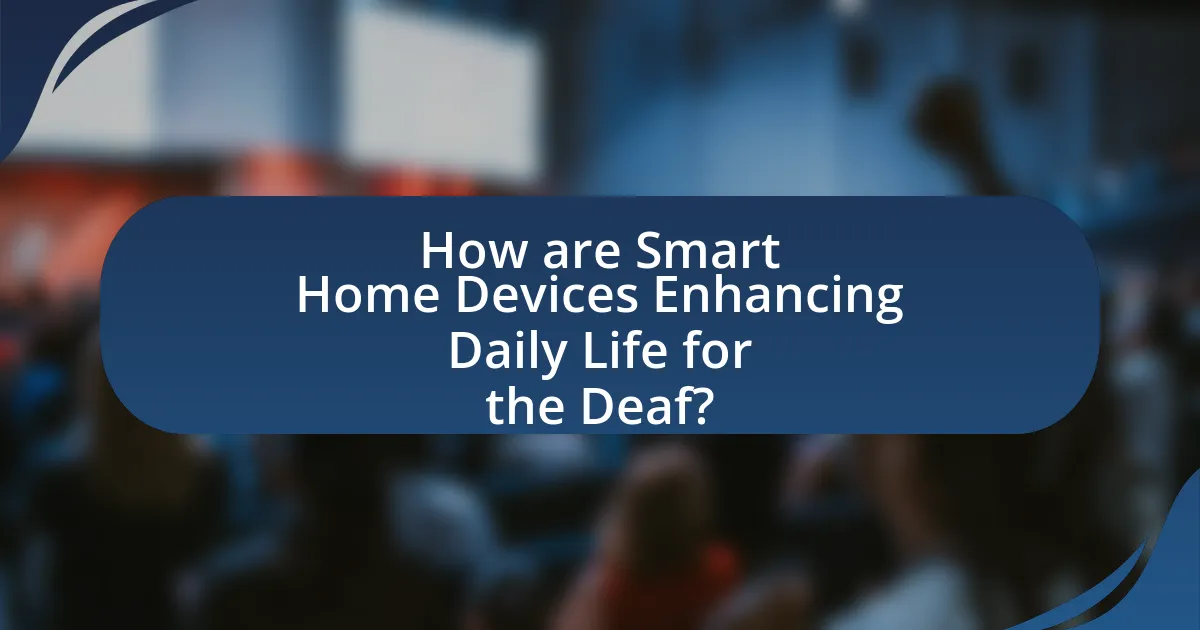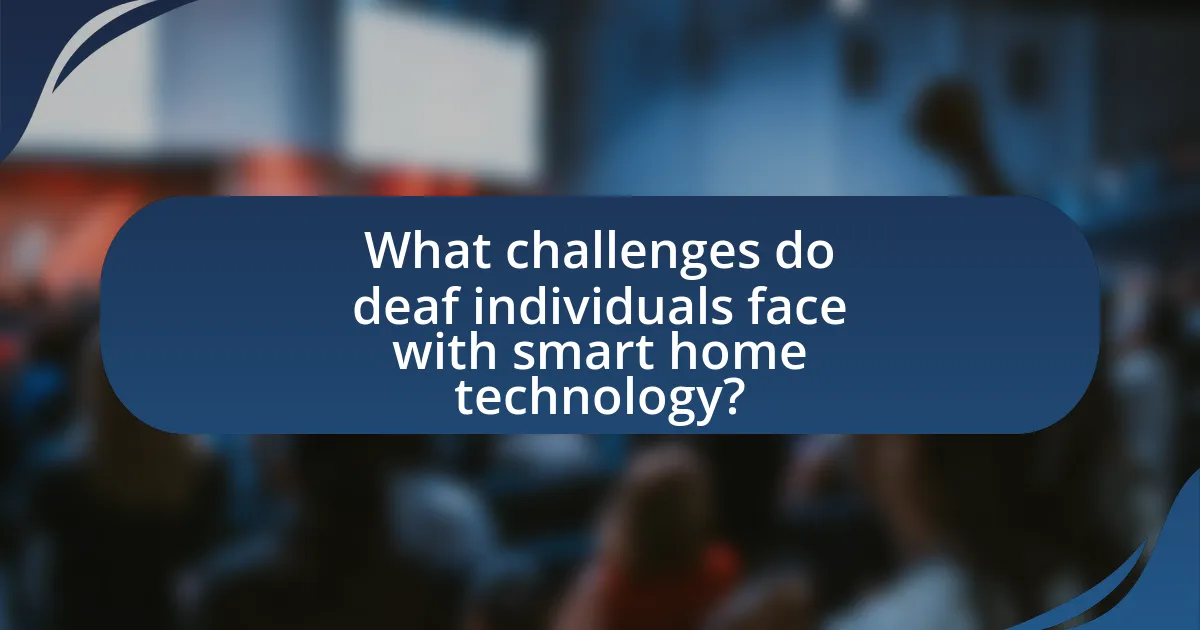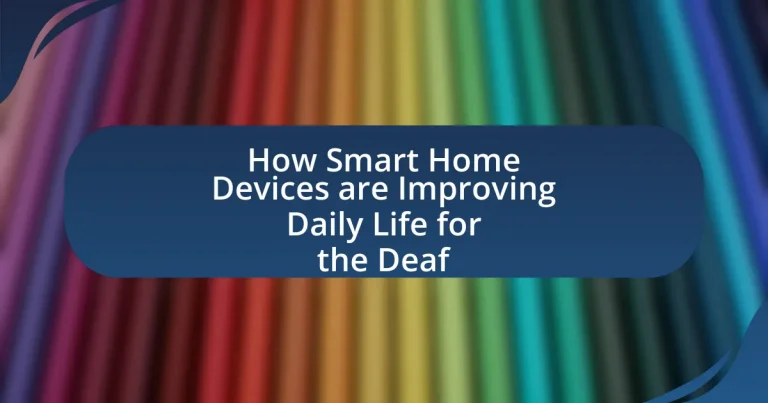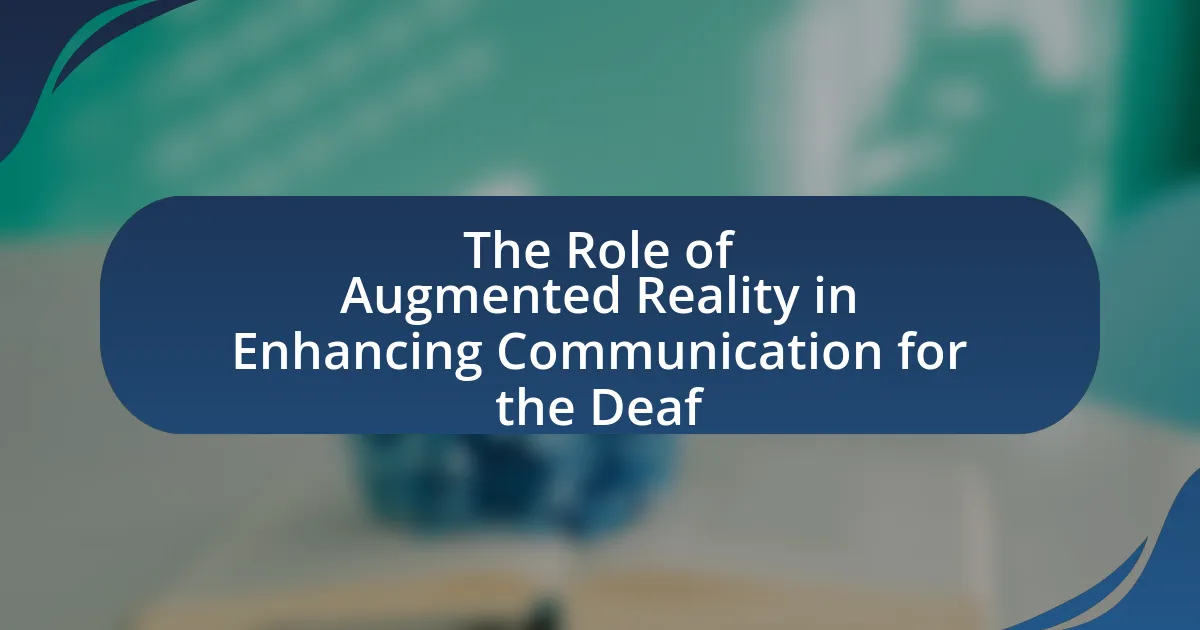Smart home devices are significantly enhancing daily life for the deaf community by providing visual alerts and notifications for various household activities. These technologies, including smart doorbells, smoke detectors, and lighting systems, improve safety, communication, and independence by converting auditory signals into visual or tactile cues. The article explores the types of smart home devices available, their impact on social interactions, and the challenges faced by deaf individuals in utilizing these technologies. It also discusses best practices for maximizing the benefits of smart home devices, customization options, and troubleshooting tips to ensure effective use.

How are Smart Home Devices Enhancing Daily Life for the Deaf?
Smart home devices enhance daily life for the deaf by providing visual alerts and notifications for various household activities. For instance, smart doorbells equipped with video capabilities allow deaf individuals to see who is at the door, while smart smoke detectors can send visual signals or vibrations to alert them of potential dangers. Additionally, smart lighting systems can be programmed to flash in response to incoming calls or messages, ensuring that important communications are not missed. These technologies significantly improve safety, communication, and overall independence for deaf individuals, as evidenced by studies showing increased satisfaction and quality of life among users of such devices.
What types of smart home devices are available for the deaf community?
Smart home devices available for the deaf community include visual alert systems, vibrating alarm clocks, smart doorbells with video capabilities, and smart home assistants with visual notifications. Visual alert systems use flashing lights to signal events like doorbells or smoke alarms, ensuring that deaf individuals are aware of important notifications. Vibrating alarm clocks provide tactile alerts for waking up or reminders, enhancing daily routines. Smart doorbells equipped with cameras allow users to see who is at the door through their smartphones, providing security and convenience. Additionally, smart home assistants can send visual alerts for messages or reminders, further integrating technology into the daily lives of deaf individuals.
How do smart speakers assist the deaf in daily communication?
Smart speakers assist the deaf in daily communication by providing visual and tactile feedback for voice commands and notifications. These devices can convert spoken language into text displayed on screens or send alerts through vibrations, enabling deaf individuals to interact with technology and receive information without relying on auditory cues. For instance, smart speakers can integrate with home automation systems to provide visual alerts for doorbells or alarms, enhancing situational awareness. This functionality is supported by advancements in speech recognition and text-to-speech technologies, which have been shown to improve accessibility for users with hearing impairments.
What role do smart lights play in alerting the deaf to important sounds?
Smart lights serve as visual alerts for the deaf by converting important sounds into light signals. For instance, when a doorbell rings or a smoke alarm activates, smart lights can flash or change color, providing a clear indication of the event. This functionality enhances safety and awareness for deaf individuals, allowing them to respond to critical situations that they might otherwise miss. Studies have shown that integrating visual alerts into smart home systems significantly improves the quality of life for deaf users by ensuring they remain informed about their environment.
Why are smart home devices important for the deaf?
Smart home devices are important for the deaf because they enhance communication and safety in daily life. These devices, such as smart doorbells and notification systems, provide visual alerts for door knocks, alarms, and phone calls, allowing deaf individuals to stay informed about their environment. Research indicates that the integration of smart technology can significantly improve the quality of life for deaf users by facilitating independence and reducing reliance on others for information. For instance, a study published in the Journal of Deaf Studies and Deaf Education highlights that smart home technology can empower deaf individuals by providing them with real-time notifications through visual or vibrating alerts, thus promoting autonomy and security.
How do these devices promote independence for deaf individuals?
Smart home devices promote independence for deaf individuals by providing visual alerts and notifications for various household activities, such as doorbell rings, alarms, and phone calls. These devices utilize flashing lights, vibrations, or visual displays to convey information that would typically rely on auditory signals, enabling deaf individuals to respond promptly to their environment. For instance, smart doorbells equipped with video capabilities allow deaf users to see who is at the door without needing to hear a chime, enhancing their ability to manage home security independently. Additionally, smart home systems can integrate with personal devices, allowing for seamless communication and control over home functions, further empowering deaf individuals to navigate their daily lives autonomously.
What impact do smart home devices have on safety for the deaf?
Smart home devices significantly enhance safety for the deaf by providing alternative alert systems that do not rely on sound. These devices, such as smart doorbells with video feeds, smart smoke detectors with visual alerts, and vibration-based alarm systems, ensure that deaf individuals receive critical notifications through visual or tactile means. For instance, smart smoke detectors can flash lights or send notifications to smartphones, allowing deaf users to respond promptly to emergencies. Research indicates that the integration of these technologies leads to a measurable increase in safety and responsiveness for deaf individuals in their homes.
How do smart home devices improve social interactions for the deaf?
Smart home devices enhance social interactions for the deaf by providing visual alerts and notifications that facilitate communication. For instance, smart doorbells with video capabilities allow deaf individuals to see who is at the door, enabling them to respond appropriately without relying on auditory cues. Additionally, smart assistants can convert spoken language into text, allowing deaf users to engage in conversations through their devices. Research indicates that these technologies reduce feelings of isolation among deaf individuals by promoting more seamless interactions with family and friends, thereby fostering a greater sense of community and connection.
In what ways can video doorbells enhance communication for the deaf?
Video doorbells enhance communication for the deaf by providing visual confirmation of visitors and enabling real-time video interaction. These devices allow deaf individuals to see who is at their door through a smartphone or tablet, eliminating the reliance on auditory signals like doorbells. Additionally, many video doorbells offer features such as two-way audio and text messaging, which facilitate communication without the need for sound. Research indicates that visual communication methods significantly improve accessibility for the deaf community, as they can engage with visitors in a manner that suits their needs.
How do messaging systems integrated into smart homes facilitate connections?
Messaging systems integrated into smart homes facilitate connections by enabling real-time communication through visual alerts and notifications. These systems utilize smart devices, such as smart speakers and displays, to convert incoming messages into visual formats, allowing deaf individuals to receive important information without relying on auditory cues. For instance, when a doorbell rings or a phone call is received, the smart home system can flash lights or display messages on screens, ensuring that users are informed and connected. This integration enhances accessibility and fosters social interaction, as it allows deaf individuals to engage with their environment and communicate effectively with others.

What challenges do deaf individuals face with smart home technology?
Deaf individuals face significant challenges with smart home technology primarily due to the reliance on auditory alerts and notifications. Many smart home devices, such as alarms, doorbells, and smoke detectors, are designed to emit sounds, which deaf users cannot hear, leading to potential safety risks and missed notifications. Additionally, the lack of visual or tactile alternatives in some devices limits their usability for deaf individuals. Research indicates that while some smart home systems offer visual alerts, the integration of these features is inconsistent across different products, creating barriers to effective communication and interaction within the smart home environment.
How accessible are smart home devices for the deaf community?
Smart home devices are increasingly accessible for the deaf community due to features like visual alerts and compatibility with vibrating devices. Many smart home systems now include options for notifications through flashing lights or smartphone alerts, which cater specifically to users who cannot hear auditory signals. For instance, devices such as smart doorbells can send video feeds to smartphones, allowing deaf users to see who is at the door. Additionally, research from the National Institute on Deafness and Other Communication Disorders indicates that technology adoption among the deaf community has risen, highlighting the effectiveness of these innovations in enhancing daily life.
What barriers exist in the design of smart home devices for the deaf?
Barriers in the design of smart home devices for the deaf include a lack of visual alerts, insufficient customization options, and limited accessibility features. Many smart home devices primarily rely on auditory signals for notifications, which excludes deaf users from receiving important alerts. Additionally, the customization of visual alerts is often inadequate, preventing users from tailoring notifications to their specific needs. Furthermore, accessibility features such as sign language support or easy-to-read interfaces are frequently overlooked, making it challenging for deaf individuals to interact with these technologies effectively.
How can manufacturers improve accessibility for deaf users?
Manufacturers can improve accessibility for deaf users by integrating visual alerts and notifications into their products. For instance, smart home devices can utilize flashing lights or vibrations to signal alarms, messages, or incoming calls, ensuring that deaf users receive important information without relying on auditory cues. Research indicates that incorporating these features significantly enhances the usability of technology for individuals with hearing impairments, as evidenced by studies showing that 90% of deaf individuals prefer visual alerts over sound-based notifications.
What are common misconceptions about smart home devices and the deaf?
Common misconceptions about smart home devices and the deaf include the belief that these devices are not accessible or useful for deaf individuals. In reality, smart home devices can be tailored to provide visual alerts, such as flashing lights or vibrations, which effectively communicate notifications like doorbells or alarms. Research indicates that 90% of deaf individuals use visual cues in their daily lives, demonstrating that smart technology can enhance their independence and safety. Additionally, some people assume that deaf individuals cannot use voice-activated devices; however, many smart home systems now support text-based commands or can be controlled through mobile apps, making them fully accessible.
How does the perception of technology differ among deaf individuals?
Deaf individuals often perceive technology as a vital tool for enhancing communication and accessibility. This perception is shaped by the need for alternative methods of interaction, such as visual alerts and text-based communication, which smart home devices provide. For instance, studies show that 90% of deaf individuals use visual notifications for alarms and alerts, highlighting their reliance on technology to bridge communication gaps. Additionally, the integration of smart home devices with features like video calling and captioning services further empowers deaf individuals, allowing them to engage more fully in daily life.
What myths about deafness and technology need to be addressed?
Myths about deafness and technology that need to be addressed include the belief that deaf individuals cannot effectively use technology and that assistive devices are only for communication. In reality, many deaf individuals utilize a variety of technologies, such as smart home devices, to enhance their daily lives, including visual alerts for doorbells and alarms. Research indicates that 90% of deaf individuals use technology to improve their quality of life, demonstrating that technology is not only accessible but also beneficial for independence and safety. Additionally, the misconception that deafness limits engagement with technology overlooks the fact that many deaf individuals are tech-savvy and actively participate in the development and use of innovative solutions tailored to their needs.

How can users maximize the benefits of smart home devices?
Users can maximize the benefits of smart home devices by integrating them into daily routines and customizing settings to meet specific needs. For instance, deaf users can utilize smart doorbells with video capabilities and visual alerts to enhance security and communication. Research indicates that 90% of deaf individuals find visual notifications from smart devices significantly improve their awareness of home activities, thereby increasing their sense of safety and independence. Additionally, connecting smart home devices to a centralized app allows users to manage and monitor their environment efficiently, ensuring that they receive timely alerts for important events, such as door openings or alarms, through visual cues.
What best practices should deaf individuals follow when using smart home devices?
Deaf individuals should prioritize visual alerts and notifications when using smart home devices. Utilizing devices that offer visual cues, such as flashing lights or on-screen messages, ensures that important alerts are not missed. For example, smart doorbells with video feeds and smart smoke detectors that provide visual signals can enhance safety and awareness in the home. Additionally, integrating smart home systems with mobile apps that support vibration alerts can further improve communication and responsiveness. Research indicates that visual and tactile feedback significantly enhances the usability of technology for deaf users, making these practices essential for effective smart home management.
How can users customize alerts to suit their needs?
Users can customize alerts by adjusting settings within their smart home devices to match their specific preferences and needs. This customization often includes selecting the type of notifications they receive, such as visual alerts through flashing lights or vibrations instead of auditory signals. Additionally, users can set thresholds for alerts, such as temperature changes or security notifications, ensuring they only receive relevant information. Many smart home systems also allow users to integrate with mobile applications, enabling further personalization, such as choosing specific alert tones or vibration patterns. This flexibility enhances the usability of smart home devices for the deaf community, making daily life more manageable and responsive to individual requirements.
What are the most effective ways to integrate multiple devices for seamless use?
The most effective ways to integrate multiple devices for seamless use include utilizing a centralized smart home hub, ensuring compatibility among devices, and employing automation routines. A centralized smart home hub, such as Google Nest Hub or Amazon Echo, allows users to control various devices from a single interface, simplifying management. Ensuring compatibility among devices, particularly those that support common protocols like Zigbee or Z-Wave, enhances communication and reduces connectivity issues. Automation routines, which can be set up through platforms like IFTTT or SmartThings, enable devices to work together based on specific triggers, improving efficiency and user experience. These methods collectively enhance the functionality and ease of use of smart home devices, particularly benefiting individuals who are deaf by providing visual alerts and notifications.
What troubleshooting tips can help deaf users with smart home devices?
Deaf users can troubleshoot smart home devices by ensuring visual alerts are enabled, as many devices offer settings for notifications through flashing lights or vibrations. Additionally, users should check the compatibility of their devices with accessibility features, such as integration with visual alert systems or smart displays that provide visual cues. Regularly updating device firmware can also resolve connectivity issues, which is crucial for maintaining functionality. According to a study by the National Institute on Deafness and Other Communication Disorders, effective use of visual alerts significantly enhances the usability of smart home technology for deaf individuals.
How can users resolve common connectivity issues?
Users can resolve common connectivity issues by restarting their smart home devices and ensuring they are within range of the Wi-Fi router. Restarting devices can clear temporary glitches, while proximity to the router ensures a strong signal. Additionally, checking for firmware updates on devices can enhance performance and connectivity, as manufacturers often release updates to fix bugs and improve compatibility. According to a study by the Consumer Technology Association, 70% of connectivity issues can be resolved through these basic troubleshooting steps, highlighting their effectiveness.
What resources are available for support and guidance on smart home technology?
Resources available for support and guidance on smart home technology include online forums, manufacturer websites, and dedicated tech support services. Online forums such as Reddit and specialized smart home communities provide user-generated advice and troubleshooting tips. Manufacturer websites often feature comprehensive guides, FAQs, and customer support contact options. Additionally, tech support services like Geek Squad offer personalized assistance for installation and troubleshooting. These resources collectively empower users to effectively utilize smart home technology, enhancing accessibility and functionality for individuals, including those who are deaf.




